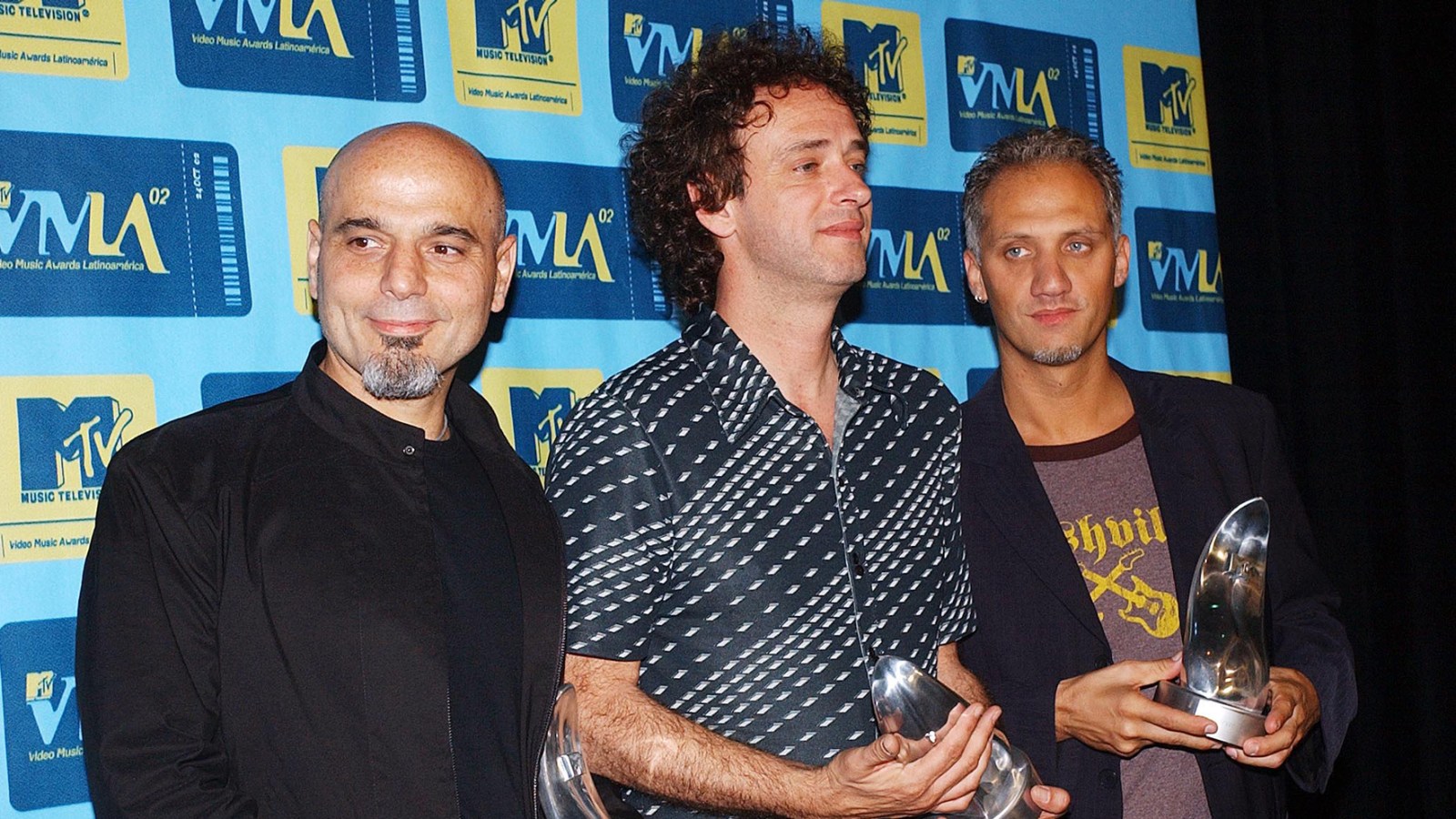First, there’s the black and white portrait. It unfolds when you’d open up the CD booklet of Sueño Stereo, Soda Stereo’s seminal album, released on June 21, 1995, 30 years ago.
The photo, taken by Cecilia Amenábar, depicts the iconic Argentine trio — singer/guitarist Gustavo Cerati, bassist Zeta Bosio, drummer Charly Alberti — at work in their private Buenos Aires studio, surrounded by a beautiful mess of guitars, keyboards, amplifiers, a drum kit, and a computer monitor that looks prehistoric by today’s standards. Decades later, the picture remains evocative, encapsulating the idealized mystique of everything a rock & roll session is supposed to look like.
And the music? It reflects the same kind of majestic, mournful introspection; a flash of genius. A visionary blend of Beatles-esque hooks, thorny psychedelia, Nineties ambient, and South American existentialism, Sueño Stereo is, beyond any reasonable doubt, Soda’s tour de force, but also one of Latin rock’s most baffling, otherworldly masterpieces — a record that never ceases to surprise and delight.
“It was an amazing time,” says Bosio from his home in Miami. “At that stage, we were completely in sync. When we played together it felt like we were a single being instead of three different people. Many of the Sueño Stereo songs stemmed from us improvising together at Supersónico, an old, now demolished home in the Belgrano neighborhood of Buenos Aires that we turned into a studio. The music poured out. We recorded jam sessions in DAT, and they quickly developed into completed songs.”
“A long time had elapsed between albums; when we reconvened, there was a moment of hesitation,” Alberti recalls. “And then we asked ourselves: What if instead of looking ahead into the future, like we always do, we take a breather and look at ourselves? I’m not talking about reversion, but rather the idea of Soda looking at Soda. Why don’t we make it a point to sound like ourselves for once?”
In retrospect, Soda never really sounded like Soda, as the trio’s restless identity kept morphing from album to album since the release of its new wave inflected 1984 debut. And because the band quickly became the official ambassador of stadium-sized rock en español throughout Latin America, every stylistic shift, every reinvention was scrutinized by fans and critics alike. In 1992, Sueño Stereo’s predecessor, Dynamo, offered a grand experiment in shoegaze. But once they were done touring behind it, everything went south.
On July 4, 1994, a car transporting Bosio’s two young children was rammed by a colectivo — the Buenos Aires public buses, often manned by notoriously aggressive drivers. The car caught fire, one of Bosio’s sons died on the scene, while the other one — now a musician himself — suffered severe burns.
Understandably, the tragedy brought the band closer together. Even though Cerati had already released a solo album — 1993’s esoteric Amor Amarillo — and harbored the desire to dismantle Soda, he pushed for the trio to reconvene, thinking perhaps that making music would provide a modicum of healing.
“By the time we started work on Sueño, we had gone through hell and back,” says Alberti.
“For Zeta, it was the toughest moment,” says producer and keyboardist Tweety González, who toured extensively with the band. “His son was only three years old and died in the most horrific way. On top of that, even though it wasn’t verbalized, there was a sense that this would be the band’s last album. As could be expected, those feelings seeped into the record.”
Not surprisingly, the album’s 12 tracks appear to float in some sort of amorphous realm, halfway between the kingdom of the living and a subaquatic, amniotic abyss. The electronica elements that permeate the record — the machine-made whirring on “Pasos,” the guitar reverb at the conclusion of “Disco Eterno” —give the songs a languid, dreamlike quality. Only the brassy minor hit “Paseando por Roma,” Cerati’s musical fantasy about riding a Vespa on the streets of the Italian capital, has the propulsive punch of previous Soda anthems.
For a band that rehearsed furiously and relished the chance to generate songs out of spontaneous jams, employing electronica had a liberating effect. Having switched labels, from Sony to the more controlling Ariola/BMG, Soda considered kick-starting their new record deal with a double album.
“It was named Sueño Stereo because the original conceit was to do a bit of mischief and have two separate records,” says Bosio with a grin. “One would house the more conventional pop songs, and the other would be totally ambient, inspired by the bands that we loved at the time: The Orb, Aphex Twin, and Orbital.”
Sadly, the label would have none of that experimental nonsense. Eager to recoup the initial investment, they pushed for a more commercial release.
“That was the duality that plagued us,” reflects Bosio. “We were a famous pop band, but with a rebellious attitude and an alternative edge. Sony had given us more freedom in that respect.”
More to the point, the sessions had yet to yield a proper lead single. According to Bosio, Cerati decried the absence of an in-your-face tune like the 1990 smash “De Música Ligera.” Even Dynamo had yielded the rollicking “Primavera 0.”
“We went back to the studio, started playing a chorus, and just like that, we wrote ‘Ella Usó Mi Cabeza Como Un Revólver’ in a single session,” says the bassist. “There was only a part missing, and we were whistling where the string section was supposed to be.”
With its strains of Cerati’s guitar, echoey electronic textures and an imperial keyboard line that evoked an aura of cinematic decadence, “Ella Usó Mi Cabeza Como Un Revólver” was not only Sueño’s triumphant opening cut, but also a clear indication of how sophisticated and articulate the trio’s vision had become. Flaunting their Beatles influences like never before, it was as powerful and finely crafted as anything by Radiohead or Massive Attack. Latin rock had arrived.
“Gustavo was incredibly brave in his aesthetic choices,” says Alejandro Terán, who contributed string arrangements and played viola on the album. “He would jump into the void laughing like a madman, without a care in the world. The most beautiful part of it was that he would carry you by the hand with that gaze of his, so electric and serene at the same time. He was also fascinated with silence.
“Even though I didn’t play on it, I have a soft spot for Sueño Stereo,” says González, who missed the sessions because he was busy working on Fito Páez’s Circo Beat. “When I finally listened to it, I wanted to kill myself. ‘Ella Usó Mi Cabeza’ is so epic, like a miniature rock opera. I think it’s their finest moment.”
In reality, the zenith of Sueño Stereo — and, arguably, of the entire Argentine rock movement — arrives at the tail end of the album, when Soda bids farewell to the world and fades into oblivion in a suite of three interconnected songs inspired by Cerati’s experiences with psychotropic substances: “Planta,” an orchestral rocker with Floydian undertones; “X-Playo,” the only surviving fragment of the shipwrecked ambient record; and “Moirè,” a delicate, hallucinogenic slice of folktronica with abstract lyrics (“cerrá la escotilla, nena, que no hay gravedad,”) and Cerati’s voice sounding even more regal than usual.
“It’s meant to be the perfect goodbye,” explains Bosio. “Inspired by those Seventies records that ended with a medley, like Pink Floyd, or Paul McCartney and Wings. You also see that in the B side of Abbey Road; the band bidding farewell. ‘X-Playo’ is a weird track. We connected two MIDI islands with Gustavo, and recorded a bunch of experimental electronica that was subtle and smooth.”
“Those are the darkest songs in the album — no wonder they show up at the end,” adds González. “It’s quite a cinematic record, filled with imagery. Gustavo’s intros lasted well over a minute — he could generate a mood even before he started singing. When you listen to Sueño, you realize what music was about in those days. Unlike today.”
The Sueño journey was not over yet. The trio traveled to London, where Cerati refined his vocal tracks, and the album was mixed by recording engineer Clive Goddard.
“I think mixing it in England gave it an international flavor,” Bosio says. “Gustavo didn’t care for hi-hats, and the English happen to love them,” Alberti adds. “The finished album sounds so incredibly well balanced because it was mixed by someone who clearly knew what he was doing.”
Still, no amount of artistic success could heal the rift that had poisoned the group. In his book Algún tiempo atrás — La vida de Gustavo Cerati, veteran journalist Sergio Marchi describes Cerati lunging at Alberti and grabbing him by the throat on a bus ride in Tegucigalpa during the Sueño tour.
“Musically, we were in a moment of glory and could have continued making great records,” says Bosio. “On a personal level, it was over. Such is the reality of bands. If one member doesn’t want to do it anymore, it’s impossible to keep going.”
“Gustavo wanted to carry on without the other two and play with other people,” says Marchi from Buenos Aires. “It’s like a guy who has been with the same girl since he was a teenager. Naturally, he wants to date other women. This wasn’t about Zeta or Charly not being good enough musicians. Gustavo was already out.”
“His creative leadership had become increasingly huge,” González agrees. “It was sort of like The Police, where Sting had all the power and everyone else was dependent on the genius of the almighty singer/songwriter. The proof is in the pudding: Where are all the great albums made by Soda’s other members? For better or for worse, it’s the actual work that speaks volumes about who you are.”
Cerati’s solo career vindicated him as one of the most transcendent artists in Latin music. Eventually, he reconciled with Bosio and Alberti for a successful comeback tour in 2007. There were even rumors of a new studio album.
But while on tour in Caracas, Cerati suffered a stroke in 2010 and remained in a coma for four years, until he passed away in September of 2014. He was 55.
“Soda was going to continue,” says Alberti. “Gustavo and I talked over the phone, had a good cry together, and told each other everything that we weren’t able to voice out in person. On Sueño we sounded free like never before. I think it’s the best record we ever made.”
“Sueño has a darkness to it that reflects everything that was going on,” Bosio says. “When we were mixing in London, I would wake up early in the morning and walk to a kindergarten nearby in the hope that my son would suddenly show up. I thought that maybe I would be able to reunite with him in England. When you are processing grief, your mind can play tricks like that.”



